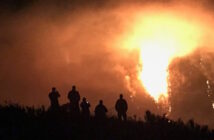A historically bad winter with storms and flooding, preceded by several years of record wildfire seasons, have tested Californians and their preparation for natural disasters.
So, what could possibly be next?
Well, California is just one – long overdue – slipped disc away from a massive earthquake. And if you think tsunamis are not a “thing” – think again.
ReadyOC, Orange County’s leading emergency preparedness website, has information on general preparedness as well as valuable emergency-specific information, including earthquakes and tsunamis.
The next ‘big one’
Earthquakes remain an ever-present threat. The 7.8 quake in February that leveled parts of Turkey and Syria provides vivid evidence of the awesome devastation temblors can wreak. Those disasters don’t just happen a half a world away. This winter, a 6.4 earthquake struck offshore of Humboldt County, toppling and damaging 15 buildings, buckling several roads and bridges, and knocking out power for more than 70,000 residents. Had the shaker occurred closer to a more populated area than Ferndale, population 15,000, those numbers would have increased by orders of magnitude. For decades scientists have warned we are just a tectonic strike-slip from the “Big One.” It’s not an if, it’s a when, where, and how bad.
Californians are surrounded by small unfelt quakes, with 75 to 100 each day. Of those, up to 500 a year can be felt by residents, according to ReadyOC.
The latest Uniform California Earthquake Rupture Forecast, issued in 2015, provides chilling, albeit mixed, predictions. For example, while the chances of an earthquake on the 6.7 magnitude level of Northridge in 1994 have decreased, the possibilities of one rated magnitude 8 or greater have increased, because it is now known that temblors can extend beyond a single fault, causing greater devastation.
“The fact that we’re now dealing with an interconnected fault system effectively has allowed larger earthquakes to occur in the model, and that has increased the rate of magnitude-8 and above events by about 20 percent,” according to Ned Field, author of the 2015 report.
A visit to ReadyOC provides valuable tips, including the “Drop, Cover, and Hold On” mantra of the Great California Shakeout. The site also has helpful videos demonstrating what to do during an earthquake. This year, the Great California Shakeout drill in most areas will be staged October 19, or the third Thursday of October, as is traditional.
Experts say when you first detect a quake, drop wherever you are to your hands and knees and hold onto something sturdy. Those in wheelchairs or using walkers with seats should lock the wheels and remain seated until the shaking stops.
Cover your head and neck with your arms. If there is a sturdy desk or table nearby, crawl underneath, or go to an interior wall away from windows. Stay on knees or bent over to protect vital organs.
If you make it under a table or desk, hold on with one hand. If seated, bend forward and cover your head and neck with both hands. If in bed, turn face down and cover your head and neck.
If you are indoors, stay inside and do not stand under doorways. In modern construction doorways are not stronger than other parts of the house and do not protect you from the most likely source of injury: falling or flying objects.
If you are in a car, pull over and set the parking brake. If outdoors, stay in an open area away from buildings, if possible.
As explained on ReadyOC, “The main point is to not try to move, but to immediately protect yourself as best as possible where you are. Earthquakes occur without any warning and may be so violent that you cannot run or crawl … You will never know if the initial jolt will turn out to be the start of the big one. You should Drop, Cover, and Hold On immediately.”
Before an earthquake strikes, identify safe places in each room of your home and take other precautions such as securing furniture and checking for gas leaks.
As with other disasters such as fires, flooding, or severe storms, it is important to be prepared. This includes having a disaster kit, a communications plan, and agreed upon meeting places decided in advance. ReadyOC has you covered with tips and suggestions in the Are You Prepared section on its homepage.
Depending on the severity of the earthquake, you may be without power, emergency personnel may not be able to reach you, your house may not be safe to occupy, and communications may be unavailable or interrupted.
To be up to date, it is worthwhile to sign up with AlertOC, a mass notification system to keep county residents and businesses informed of emergencies that may require immediate life saving actions. Because earthquakes, unlike other disasters, can strike quickly and without warning, seconds can be invaluable.
Earthquake California has links to free apps for iPhone and Android devices that connect to the country’s first publicly available, statewide warning system that could give California residents crucial seconds to take cover before shaking begins.
Catching a wave
Tsunamis may not be high on the radar of many, but they definitely are “a thing.”
California recently held a Tsunami Preparedness Week, with events attended by more than 42,000 Orange County residents. The National Weather Service has information on Tsunami preparedness and United National has a Tsunami Awareness Day.
Caused most often by earthquakes, either locally or as far away as Asia, tsunami surges can travel thousands of miles with devastating consequences. Although rare in California, the entire coastline is exposed.
In 2022, a volcanic eruption on an uninhabited island in the Pacific led to the Tonga tsunami. The first to flood land in California since 1964, the tsunami caused beaches and several harbors in northern and central California to experience minor to moderate flooding damage.
In 2011, the Tōhoku-oki earthquake and tsunami, which devastated Japan, also caused $10 million in damage in the U.S., including damage at the ports of Long Beach and Los Angeles. Luckily, because the tsunami arrived at low tide, there was virtually no flooding.
The National Tsunami Warning Center in Humboldt has the responsibility of warning Canada and the rest of the United States, including California.
ReadyOC has a video on tsunami preparedness as well. Residents are advised to listen for emergency information, such as alerts, on AlertOC. In the event of a warning, people should follow marked tsunami zone evacuation routes if possible and proceed inland to higher ground. Even if outside a tsunami hazard zone, it is advised to stay in place until authorities say otherwise. And as always, have an evacuation kit ready.
California has abundant wonders, but also more than its share of potential natural disasters. In all cases, preparedness is key.
So what’s next? Asteroids?
 Behind the Badge
Behind the Badge



